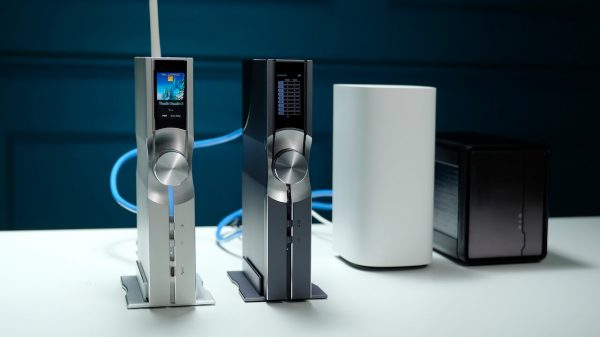Hardware is only as good as the software that runs it and there is no question that some of the platforms currently running network streamers and wireless loudspeakers are sorely lacking.
A fancy and slick interface (Sonos) might get you inside the club, but when search features are antiquated, multi-room system setup takes much longer than it should, and the damn thing freezes on a daily basis — the hardware becomes nothing more than an expensive piece of furniture gathering dust.
Sonos has proven that the software experience is actually more important than the hardware for most consumers and it is clear that Lenbrook (NAD, DALI, PSB and Bluesound), Naim, WiiM Audio, and Cambridge Audio have come to that realization as well.
If it takes more than 20 minutes to setup access to all of your streaming platforms, integrate Roon if you utilize that platform, connect your digital hub to your home network and multi-room wireless loudspeakers — there is something seriously wrong with the software.

BluOS has not always had the slickest interface but I’ve managed to use it successfully at home and work for almost 4 years; integrating TIDAL, Qobuz, Spotify, and Roon proved to be a mixed bag from the perspective of slower than ideal performance, but the platform is robust and has never derailed any review of NAD, PSB, Cyrus Audio, DALI, or Bluesound components and wireless loudspeakers under review.
But what has become clear to those of us who use BluOS on a daily basis is that the platform needs an interface update, easier search, and faster performance.
All of that is coming in mid-October, although it was previously due out earlier this year. Lenbrook will be offering a preview of BluOS 4.0 at CEDIA 2023 in Denver at Booth #3516. Robert Silva and Chris Boylan will be reporting back from the show with their initial impressions of the new mobile version of the platform.
The update revitalizes the BluOS Controller app experience with several improvements – a redesign of the user interface, better navigation, and improved search functionality, to deliver a more personalized way to play and control music across multiple zones.
“We’re thrilled to introduce BluOS 4.0 following a rigorous development journey,” expresses Andrew Haines, BluOS Product Manager, “The complete transformation of the mobile app interface underscores our dedication to providing BluOS users with an impeccably smooth and cohesive experience.”
Starting October 17th, users will be prompted to download the official firmware update by following the prompts on the BluOS Controller app, available for both iOS and Android devices.

What is BluOS?
BluOS is a premium multi-room audio ecosystem that manages stored and cloud music sources and playback, with support for high-resolution audio streams up to 24bit/192kHz.
Adopted by some of the most renowned residential hi-fi and commercial audio brands and integrated with numerous IoT and voice control systems, BluOS allows for interoperability among enabled devices across brands for maximum versatility and use cases.
Integrations with popular streaming music services like TIDAL, Spotify, SoundMachine, and SiriusXM for Business, as well as featuring support for MQA, FLAC, AAC, and other high resolution formats and codecs, BluOS offers virtually unlimited access to music of all genres for any occasion. Made up of an operating system and a control application for smartphones, tablets, and PC desktops, BluOS is a comprehensive and easy to use platform for the modern audiophile or customer experience professional.

Key Highlights:
- Improved Navigation
- All-new bottom navigation bar with easily identifiable icons for Home, Favorites, Music Players, and Search delivers quick, one-tap access to the most important app features
- Customized Content
- Favorites screen delivers quick access to users’ favorite content with a customizable view by playlists, artists, albums, songs and stations
- Centralized Access
- Music screen combines music sources, music services and device inputs all in one area so users can easily switch back and forth between connected zones
- Improved Player Control
- Users can now toggle easily between Now Playing and Play Queue screens, with new icon for grouping, and indicators for sampled audio quality and zone playing added
- Better, Faster Search
- New dedicated Search screen searches by music service for more specific and faster results
Stay tuned for our impressions from the show and in early-October 2023 when we can try BluOS through a number of NAD and Bluesound components.
For more information: bluos.net
Related reading:

































Mike Cornell
August 30, 2023 at 7:57 pm
Would like to see Apple Music integration as per Sonos (though Sonos is not bit perfect) and especially as in the Eversolo DMP-A6 where you can download the Apple Music app and play music natively and bit perfect to boot. No need to tie up your phone/iPad over AirPlay 2.
Eric Burbeck
August 31, 2023 at 11:04 am
Yes, I’m also very much hoping that happens. Probably will switch to the DMP-A6 in the next few months as a result (assuming Bluesound doesn’t add native Apple Music integration).
Max Rayapen
August 31, 2023 at 9:53 am
Sounds good. But no mention of the releases date for the Tidal Connect update. Tidal has launched new tracks in 24 bit 192 kHz in FLAC format. Will the two be released together? As a tidal connect fan , I am still waiting.
Bob Muenchen
August 31, 2023 at 11:17 am
I wish I could get Dolby Atmos out of a BlueSound Node via HDMI. Is the software preventing that, or hardware?
Richard Whybrow
September 3, 2023 at 2:50 am
I’m hoping the Libraries search for Bluesound locally hosted music will store a larger range of titles and artwork.
In both NAS (Network Attached Storage ) & USB stored music the capacity seems very much limited in the current version.
E.D.B.
September 3, 2023 at 1:16 pm
If the new update doesn’t include the once-standard function of playing locally stored music in the Android device, this is a failure. With phone & tablet processors as efficient as ever, who wants to use a computer as a network server in 2023 ? It’s not environmentally friendly.
BlueSound had better give users the local option back or else I will continue to not recommend this product.
Gord Cornett
November 12, 2023 at 10:05 pm
The downside to the latest Blue Sound update for me and at least one other node owner is that it no longer recognizes the USB in put from my portable hard drive. It worked great up until the latest update and now USB no longer shows up as a music source.
Not impressed at all. Contacted Bluesound and nothing for 2 weeks now.